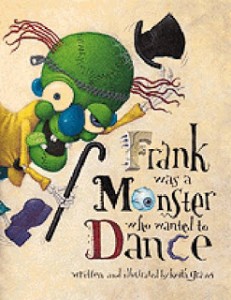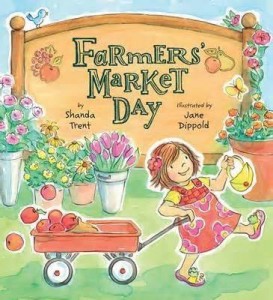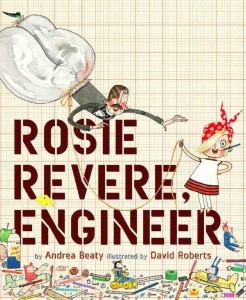Frank Was a Monster Who Wanted to Dance
 Here’s a treat for you this Halloween: a rhyming picture book that will delight your little monsters while you hit the CCSS of Fluency and Phonics & Word Recognition.
Here’s a treat for you this Halloween: a rhyming picture book that will delight your little monsters while you hit the CCSS of Fluency and Phonics & Word Recognition.
Frank was a Monster Who Wanted to Dance by Keith Graves is simple, spooky, silly fun. Frank’s dancing delights the audience until his body parts start to come loose, but even a cold shoulder from the crowd (see what I did there?) can’t diminish Franks’s love of performing.
There are plenty of simple rhymes for early elementary students to catch (“ants in his pants”, etc.) and I love that students can listen to them while they enjoy this story on TumbleBooks. Many school, public, and state libraries have subscriptions to this great website where kids can hear books read aloud. TumbleBooks has picture books, chapter books, fiction and nonfiction, all kinds of titles to help students build fluency. An extra bonus: TumbleBooks also has a section of lesson plans for teachers, including a K-2 lesson plan for Frank was a Monster Who Wanted to Dance!
So read aloud this book to your class, or log into TumbleBooks and project it so the entire class can enjoy it. If your little wigglers are anything like mine, they’ll want to move their bodies like Frank did, so on repeated readings, encourage listeners to act out the text. Kids can mime brains flopping out, arms falling out of sleeves, etc. For Halloween, or for anytime your mini-monsters need an active read-aloud, this book does the trick.
For more about the author/illustrator, please visit: keithgravesart.com.
Read MoreKnock, Knock!
 Trent, one of my preschool pals, couldn’t stop giggling as he told me this gem, “So, a horse walks into a bar and the bartender says, ‘Hey, why the long face?'” Kids love good jokes – and they don’t seem to mind the bad jokes, either! Joke books are perfect for early and reluctant readers because:
Trent, one of my preschool pals, couldn’t stop giggling as he told me this gem, “So, a horse walks into a bar and the bartender says, ‘Hey, why the long face?'” Kids love good jokes – and they don’t seem to mind the bad jokes, either! Joke books are perfect for early and reluctant readers because:
1. Jokes are short.
2. You can flip through pages instead of reading sequentially so the thick books aren’t intimidating.
3. Humor makes them intrinsically motivating.
4. With “knock, knock” jokes, kids can already read some of the most important words (and you can use them for a great mini-lesson on those letter-sound combos of kn and wh.)
5. Joke books build Fluency and hit Range of Reading (two CCSS with one stone!)
My latest favorite joke book is Knock, Knock! illustrated by fourteen artists and published by Dial Books for Young Readers. Each artist chose a different “knock, knock” joke to illustrate. The repetition of words like “knock, knock” and “who’s there” plus the clues from the art make this book one most kids can read successfully, especially if you read it aloud first and let students guess what the punchlines to the jokes will be.
Rereading joke books in order to learn the jokes for future telling is probably the most fun way to build reading fluency. Make Knock, Knock! and other joke books available during choice reading time, then give your budding comedians a set time to tell jokes. This can be a one-time laugh-fest, or an ongoing event in your classroom. I liked to claim the end of the day as “Open Mike Time”. If students could gather their belongings and prepare for departure quickly, we’d have time for an “open mike” session where kids could come to the front of the room and tell a joke. This encouraged kids to get ready without dawdling, and for those who liked joking all day long, I could say, “Suzy, we won’t have time for Open Mike if we don’t use this time wisely.” Suddenly, being a class clown (at the appropriate time) is a good thing!
Read More
Rosie Revere, Engineer
I have the best of reasons for posting late this week: I’ve been on Mackinac Island at the Michigan Reading Association conference, being inspired by dedicated educators and loving the slower pace of an island with no automobiles. Now I’m sitting in a white wicker rocking chair with a cup of coffee and my laptop, dear husband at my side, watching sailboats glide by. The only thing that could make this any better would be a great book, and luckily, I have one.
Rosie Revere, Engineer written by the marvelously talented Andrea Beaty and illustrated by David Roberts is one of the rare rhyming book gems: the story is as solid as the meter and the language isn’t dumbed down in order to make a rhyme. Rosie Revere is the kind of girl most creative people will relate to: joyfully inventive, but so fearful of failure and ridicule that she hides her inventions away. The “gadgets and gizmos” she creates are fantastic, and I love Roberts’ whimsical and yet credible drawings of them. (I myself would love a pair of Rosie’s helium pants.) Rosie’s desire to help her great-great-aunt Rose fulfill her lifelong dream of flying gives Rosie the courage to test one of her inventions.
“The heli-o-cheese-copter sputtered and twitched.
It floated a moment and whirled round and round,
then froze for a heartbeat and crashed to the ground.”
Rosie is devastated by the failure, and by her great-great-aunt’s laughter, until she hears,
“‘Your brilliant first flop was a raging success!
Come on, let’s get busy and on to the next!’“
So not only is the message of this book one that every creative person with perfectionist tendencies needs to hear (I’m keeping it by my bedside table as a reminder) but it has historical notes in it about Amelia Earhart and E. Lillian Todd (the first woman to design airplanes) and Rosie the Riveter and other strong women whose names and deeds should be known. For a social studies lesson, you could easily springboard from this book into studying awesome women inventors. For math-science-art, get graph paper and a bunch of doodads and thing-a-ma-bobs for students to plan, design, build, test, and refine their own inventions. If you ask people to donate old, broken electronic gadgets to your class and bring in small tools, your students can take apart old radios and remote controls to disassemble and use. Build those Phonological Awareness skills by focusing on the rhyme, then discuss the interesting word choices for a Craft & Structure lesson. To keep rocking those Core Standards in Reading, you can easily work in Integrating Knowledge & Ideas by comparing Rosie Revere, Engineer to Iggy Peck, Architect by the same power duo.
So share this book with absolutely everyone you know, and get busy taking creative risks, because
“Life might have its failures, but this was not it.
The only true failure can come if you quit.”
For more information on the author, please visit andreabeaty.com.
For more information on the illustrator, please visit davidrobertsillustration.com.
Farmers’ Market Day
 I am counting the days until my local farmers’ market opens. Until then, I’m glad I found this perfect pick: Farmers’ Market Day written by debut picture-book author Shanda Trent and illustrated by Jane Dippold. This rhyming book is a quick read that can easily be turned into an interactive “imagination” station or a fun math center for students to practice counting money.
I am counting the days until my local farmers’ market opens. Until then, I’m glad I found this perfect pick: Farmers’ Market Day written by debut picture-book author Shanda Trent and illustrated by Jane Dippold. This rhyming book is a quick read that can easily be turned into an interactive “imagination” station or a fun math center for students to practice counting money.
A little girl and her family go to the farmers’ market on Saturday. The little girl has her own money from her piggy bank and she’s not sure what to buy – maybe a basket of cherries, a jar of honey, freshly-baked bread or flowers for the garden? Each enticing item is labeled with a price tag, like $2.00, or 12/$3.00, or 50 cents. Reading aloud this short rhyming book will have your little listeners eager to choose what they’d buy for themselves, and that’s where you can extend the book in ways to draw your students back to rereading.
Younger students can make their own farmers’ market in a pretend-play area. Plastic fruits, vegetables, and flowers can be bought and sold. Students can use Farmers’ Market Day to decide what should be for sale and how much to write on each price tag. (Using the information found in both the text and the pictures is a way of Integrating Knowledge and Ideas. Woohoo!) Older students can use the book to practice money skills. Ears of corn cost $3.00 per dozen – how many ears of corn do you need to feed your class, and how much will it cost? If you have $10.00, what items would you buy? Show your shopping list! With summer and real live farmers’ markets just around the corner, Farmers’ Market Day is a real treat.
Read More







